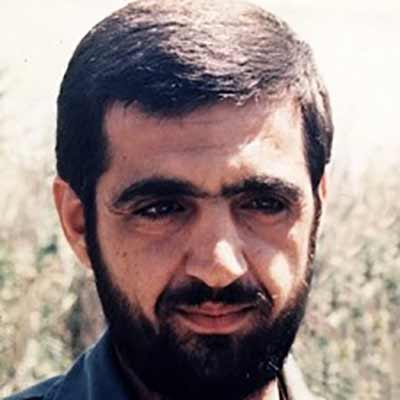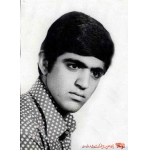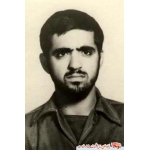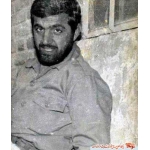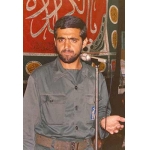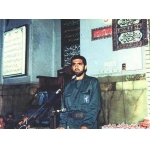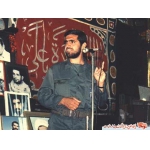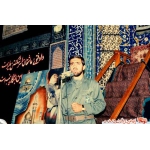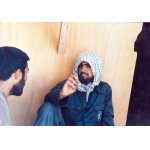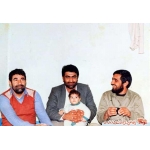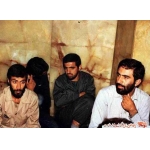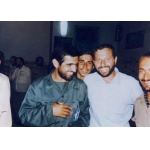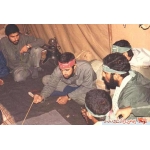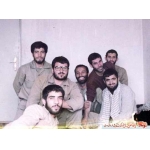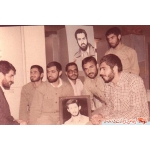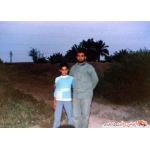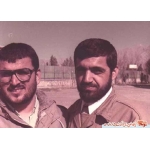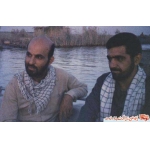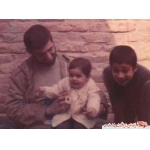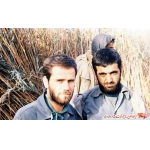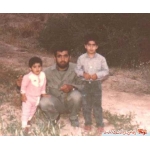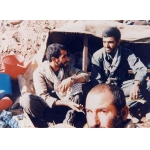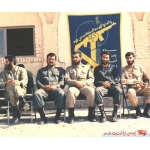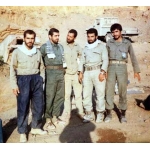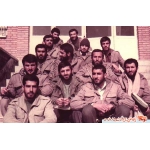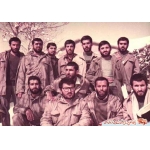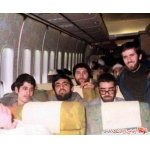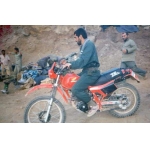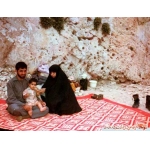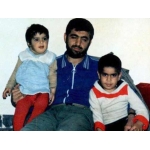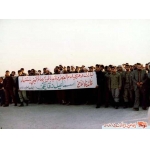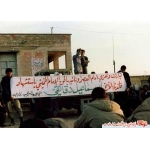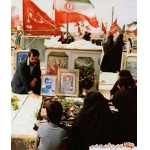People
Daqayeqi, Ismaeil
Zeinab Ahmadi
222 Views
Ismaeil Daqayeqi, the commander of the Badr Division, was martyred on January 18, 1987, during Operation Karbala 5 in the Shalamcheh.
Ismaeil Daqayeqi was born on June 29, 1954, in Behbahan. His father, Qanbar, was a tailor, and his mother was named Nosrat.[1] In 1970, after passing the Iranian University Entrance Exam, he continued his studies at the Technical High School of the National Iranian Oil Company in Ahvaz. In 1971, during his second year at the technical high school, he along with several friends, including Mohsen Rezaei, formed an organization that was later named the Mansouroun Group (a group that advocated armed struggles to overthrow the Pahlavi regime).[2] In the fall of 1974, along with four others, Daqayeqi was arrested for anti-Pahlavi activities. Due to his underage status, he was detained for two months in a juvenile correctional center, spending about nineteen days in solitary confinement.[3] In 1974, he was admitted to the Irrigation Engineering program at the College of Agriculture, Ahvaz University. However, seeking a better environment and to join his activist friends, he took the Iranian University Entrance Exam again in 1976 and was accepted into the Educational Sciences program at the University of Tehran. He then joined the Islamic Association of Tehran University Students and the Mansouroun Group.[4]
In 1977, Daqayeqi opened a large library at the Grand Mosque of Omidiyeh, where he organized Quranic interpretation and ideological courses and disseminated messages from Imam Khomeini and revolutionary clerics.[5] After the victory of the Islamic Revolution, his revolutionary activities continued. In 1979, the student organizations decided to unify into one single organization. Members of the Islamic Association held sessions to draft a charter, during which students affiliated with the Mojahedin-e Khalq Organization (Munafiqeen) tried to remove Imam Khomeini’s name from the draft. Ismaeil Daqayeqi was among the students who insisted on including the principle of Velayat-e Faqih (Guardianship of the Clerical Jurist) and Imam Khomeini’s name in the charter.
In 1979, Daqayeqi, along with his friends, established the Jihad of Construction Organization in Aghajari.[6]
On June 3, 1979, Daqayeqi married his cousin, Masoumeh Hamrahi.[7] In the same year, he founded the Aghajari branch of the Islamic Revolutionary Guard Corps (IRGC) recruiting thirty personnel.[8] In 1980, he contributed to forming the IRGC in Khuzestan and its surrounding towns and was responsible for selecting commanders for IRGC bases. Before the outbreak of the Iran-Iraq War, despite being the head of the IRGC Coordination Office, he alongside Muhammad Jahanara played a key role in managing border clashes with Iraq.[9]
With the onset of the Iran-Iraq War, Daqayeqi represented the IRGC in the War Room of the 92nd Armored Division of Ahvaz. On October 23, 1980, he traveled to Dasht-e Azadegan and, by assuming command of the Susangerd IRGC, began organizing and reinforcing the town’s defensive lines. He served there for about one year attending all the military meetings on Khuzestan’s situation and frequently inspecting the frontlines in Abadan, Mahshahr, Darkhoveyn, Susangerd, Hoveyzeh, Shush, and Dezful.[10]
He participated in Operation Tariq al-Quds that was executed on October 30, 1981, in Bostan.[11] During Operation Fath al-Mobin (March 22, 1982, Shush and Dezful),[12] he was serving alongside Martyr Baqaei, the commander of the Fajr Division.
In Operation Beit al-Muqaddas (April 30– May 24, 1982, west of Karun River),[13] he was serving in command headquarters. After this operation, Daqayeqi was transferred to the First Region of the IRGC, and in November 1982, he became the deputy head of the Security Unit in Qom and Markazi Provinces. The unit’s activities included inspecting bases, organizing seminars, and protecting delegations coming from Islamic countries to Iran. In the meantime, he was studying in the seminary as well.[14]
In 1983, Daqayeqi wrote a letter to Mohsen Rezaei (Commander-in-Chief of the IRGC), requesting relief from his current duty to participate in the battlefronts. In response, Rezaei assigned him to implement the Malik Ashtar Plan (a training course for senior IRGC commanders to enhance their knowledge of classical military techniques). Daqayeqi completed running this program by the summer of 1984. He participated in Operation Kheibar and later joined the Ali ibn Abi Talib (as) Division, where he worked on organizing the division alongside Mahdi Zainuddin (the division commander) as the head of its planning and operations unit.[15]
After Operation Beit al-Muqaddas, the Basij Mujahedin of Iraq Unit (comprising young Iraqi Mujahedin stationed at Shahid Sadr Garrison, 20 km from Ahvaz) was formed. Later, they were organized as the Imam Sadiq (as) Brigade. In early 1985, Ismaeil Daqayeqi assumed command of this brigade the name of which was changed after Operation Badr to the 9th Badr Brigade.[16]
Under Daqayeqi’s command, the 9th Badr Brigade engaged in five operations. To prepare the brigade for Operation Quds 4, which was carried out on July 23, 1985,[17] in the Umm al-Naaj Lake near Hour al-Hoveyzeh with the aim of liberating part of the lake, he ran intensive training courses on swimming, diving, and boating. Operation Ashura 4 which was successfully carried out on October 23, 1985,[18] resulted in the complete liberation of Umm al-Naaj Lake. Daqayeqi’s strategy of creating an eight-kilometer waterway behind the Iraqi command headquarters surprised the Iraqi forces and led to achieving swift success. Subsequently, Operation Karbala 2 was executed on September 1, 1986,[19] on the northern front at Haj Omran. The Badr Brigade also engaged in Operation Karbala 4 launched in the southern front at Abu al-Khasib, which commenced on December 24, 1986.[20] Before this operation, Ismaeil Daqayeqi had assigned three hundred fighters to wear Iraqi army commanders’ uniforms and attack the rear of the enemy formation.[21] Operation Karbala 5 began on January 9, 1987, in Shalamcheh, and lasted until February 21.[22] By this time, the Badr Brigade had been upgraded to a division. In this operation, the Badr Division was assigned to two operational zones: Musian and Hoveyzeh. Therefore, Daqayeqi decided to divide his forces into two groups.[23]
On Sunday, January 18, 1987, while scouting the front lines in the Shalamcheh operational zone, Ismaeil Daqayeqi was martyred after being struck by shrapnel to the head. His grave is in Omidiyeh.[24]
In 2014, the third bridge over the Karun River in Ahvaz was named after Martyr Ismaeil Daqayeqi.[25] Also, in the same year, his statue was unveiled in Ahvaz.
[1] Farhang-e Alam-e Shuhada (Encyclopedia of the Martyrs’ Names): Ostan-e Khuzestan, Vol. 1, Tehran: Shahed, 1395, p. 555.
[2] Daeratolmaaref-e Enqlab-e Eslami (Encyclopedia of the Islamic Revolution), Vol. 3, Tehran: Sureh-ye Mehr, 1394, p. 360.
[3] Saeedi, Mustafa, Khorshid-e Badr (The Sun of Badr), Tehran: Vahid-e Tablighat va Entesharat-e Sepah-e Pasdaran-e Enghlab-e Eslami, 1369, Pp. 13, 17, and 18; Shahed-e Yaran, No. 87, Dey 1391, Pp. 5 and 15.
[4] Saeedi, Mustafa, Khorshid-e Badr (The Sun of Badr), Pp. 17 and 18; Marj, Ali, Nimeh Penhan-e Mah 4 (The Hidden Half of the Moon 4): Daqayeqi be Ravayat-e Hamsar-e Shahid, Tehran: Rawayat-e Fath, 1381, p. 20; Farhang-e Alam-e Shuhada (Encyclopedia of the Martyrs’ Names): Ostan-e Khuzestan, Vol. 1, p. 555; Shahed-e Yaran, Ibid, p. 6.
[5] Shahed-e Yaran, Ibid, p. 6.
[6] Saeedi, Mustafa, Khorshid-e Badr (The Sun of Badr), Pp. 25 and 26; Marj, Ali, Nimeh Penhan-e Mah 4 (The Hidden Hald of the Moon 4), p. 9.
[7] Marj, Ali, Nimeh Penhan-e Mah 4 (The Hidden Hald of the Moon 4), p. 9.
[8] Saeedi, Mustafa, Khorshid-e Badr (The Sun of Badr), p. 26.
[9] Ibid, Pp. 28 and 29.
[10] Ibid, Pp. 30 and 31.
[11] Rashid, Mohsen, Atlas-e Jang-e Iran va Iraq (Atlas of the Iran-Iraq War), Tehran: Markaz-e Motaleat va Tahqiqat-e Jang-e Sepah-e Pasdaran-e Enghlab-e Eslami, 3rd Edition, 1379, p. 47.
[12] Ibid, p. 48.
[13] Ibid, p. 49.
[14] Saeedi, Mustafa, Khorshid-e Badr (The Sun of Badr), Pp. 30–32; Shahed-e Yaran, Ibid, p. 9.
[15] Saeedi, Mustafa, Khorshid-e Badr (The Sun of Badr), Pp. 33–38.
[16] Shahed-e Yaran, Ibid, p. 38.
[17] Nakhaei, Hadi; Farahani, Hamidreza, Roozshomar-e Jang-e Iran va Iraq (Chronology of the Iran-Iraq War), Book 37: Toseeh-ye Ravabet ba Qodrat-ha-ye Asiyayi (Expanding Relations with Asian Powers), Tehran: Markaz-e Motaleat va Tahqiqat-e Jang-e Sepah-e Pasdaran-e Enghlab-e Eslami, 1383, p. 483.
[18] Habibi, Abolqasem, Atlas-e Khuzestan dar Jang-e Iran va Iraq (Atlas of Khuzestan in the Iran-Iraq War), Tehran: Markaz-e Asnad va Tahqiqat-e Defa-e Muqaddas, 1393, p. 204.
[19] Rashid, Mohsen, Atlas-e Jang-e Iran va Iraq (Atlas of the Iran-Iraq War), p. 88.
[20] Ibid, p. 76.
[21] Shahed-e Yaran, Ibid, Pp. 81 and 82.
[22] Rashid, Mohsen, Atlas-e Jang-e Iran va Iraq (Atlas of the Iran-Iraq War), p. 77.
[23] Saeedi, Mustafa, Khorshid-e Badr (The Sun of Badr), Pp. 76 and 80; Shahed-e Yaran, Ibid, p. 82.
[24] Farhang-e Alam-e Shuhada (Encyclopedia of the Martyrs’ Names): Ostan-e Khuzestan, Vol. 1, p. 555; Shahed-e Yaran, Ibid, p. 11.
[25] Rooznameh Karun (Karun Newspaper), No. 3318, 20 Dey 1393, p. 4.




